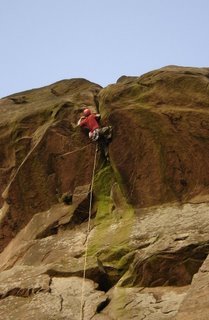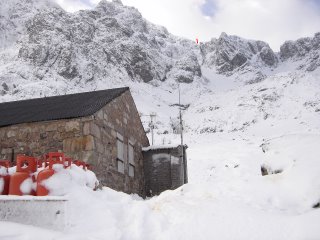I had seen this route two years ago in my first visit to The Roaches, nobody was climbing it that day, and I could only dream of ever tackling something like that. But time passes by and we get stronger, and after having bagged one E1 and another E2, there was no excuse for me anymore not to do this route. So being at The Roaches again this weekend meant that I HAD to tackle it. I spent the whole Saturday morning pondering it, looking at it from far away, watching one candidate struggling and falling off, just to get back on and conquer it. What a route.
In the afternoon my moment of reckoning arrived, I had to do a route, and it was to be The Sloth or nothing. Like a doomed animal I approached the base of the climb, and slowly went up, getting closer and closer to the dreaded overhang. As it drew nearer, it became more and more terrifying, and my level of disbelief in myself kept growing and growing. Just at the bottom of the overhang there is a big 'cheese' block where one big sling can be put around. This is really sound protection, but being right at the bottom means that falling at the crux of the overhang implies a whipper and a big smash against the lower wall and ledge below. Indeed, stories abound about broken ankles and shattered egos, giving this climb a bit of a reputation.
At the crux point there is a wide crack where a bomber hexe can be placed, but you have to put this piece of gear while you are hanging in the 'sloth' position, while your strength is being drained away and your brain becomes increasingly unsettled. I tried three times to reach the crack to place the hexe, and three times I was unsuccessful and climbed down to the lower ledge. The fourth time would be the last try. My right arm was already pumped, and I would not have the strength for a fifth attempt. So it was all or nothing. Get to the top or fall down.
I took the biggest hex and put it firmly in my mouth, and set off to conquer the mighty roof. I tried to keep my concentration, placing my feet carefully, laybacking my way up the overhanging flake, jamming my left foot into a big block, and bridging with the right one. One pull up on my right arm and I was able to stretch and place the hexe, a truly beautiful placement. I kept my nerve and confidently took in some rope and clipped it to the newly placed runner. After that everthing happened in a flash. My left hand reached for the upper flake followed promptly by the right one. Big handholds kept appearing all the way, as I sprinted up. At the critical point I reached the famous upper crack, where a solid fist jam helps the final push. As I put my right fist into the crack it felt like melted butter, it wasn't going to hold, but I had no other chance. The hex at that point felt like it was placed miles below. With a final push of blind faith, I let all my body weight on the jammed hand, and thanks God, it did hold. My left hand finally reached the final jug and milliseconds afterwards I was finally over the roof, with my right knee firmly jammed into the upper off-width crack, panting like I had just ran a marathon. The rest of the climb was easy, and as I reached the safety of the belay, I could only gaze into the distance and admire the impressive view, the valleys bellow engulfed by the autumn mist. And there, relieved and happy for a job well done, you discover why trad climbing is so fascinating!
Yours truly on his little epic (The Sloth, 5a HVS):




